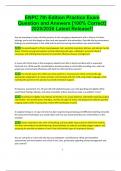ENPC 7th Edition Practice Exam
Question and Answers [100% Correct]
2025/2026 Latest Release!!
You are assessing a 6-year-old who presents to the emergency department with a history of a fever,
lethargy, and a rash that began on the trunk and spread to the extremities. Describe the key assessment
findings you would expect in this child and the priority nursing interventions you would initiate.
You would expect to find a maculopapular rash, potential respiratory distress, and altered mental
status. Priority nursing interventions include obtaining vital signs, initiating IV access for fluids if
necessary, and notifying the physician for potential infectious disease management.
A 4-year-old child arrives at the emergency department after a bicycle accident with a suspected
fractured arm. What specific considerations should you keep in mind while providing care, and how
would you communicate effectively with both the child and their parents?
You should assess the child's pain level, perform a neurovascular check, and provide age-
appropriate explanations to reduce anxiety. Communicate with the child using simple language, while
involving the parents in the process to provide emotional support.
During your assessment of a 10-year-old with abdominal pain, you note guarding and rigidity. What
could these findings indicate, and what immediate actions should you take as a pediatric nurse?
Guarding and rigidity may indicate peritonitis or an acute abdomen, potentially requiring surgical
intervention. You should assess vital signs, monitor for signs of shock, and prepare the child for possible
imaging studies while ensuring they remain NPO (nothing by mouth).
A caregiver brings in a 3-year-old who has been experiencing wheezing and difficulty breathing. Describe
the assessment techniques you would utilize and how you would prioritize your interventions in this
situation.
Assess respiratory rate, work of breathing, and auscultate lung sounds to determine severity.
Prioritize interventions by administering a bronchodilator as ordered, providing oxygen support, and
preparing for possible escalation of care if the child exhibits signs of respiratory distress.
You are caring for a 5-year-old who has just undergone a tonsillectomy. What post-operative
assessments and interventions are critical in this case, particularly regarding airway management and
pain control?
1
, Monitor for airway obstruction, assess for signs of bleeding, and evaluate pain levels. Position the
child comfortably, encourage fluid intake, and administer prescribed pain medications while educating
parents on what to watch for at home, such as excessive swallowing indicating bleeding.
In the emergency department, a 2-year-old presents with a high fever, irritability, and a bulging
fontanelle. What differential diagnoses would you consider, and what initial nursing actions would be
necessary?
Differential diagnoses may include meningitis or an intracranial infection. Initial nursing actions
include performing a thorough neurological assessment, monitoring vital signs closely, ensuring IV access
for potential fluids and antibiotics, and preparing for a lumbar puncture if indicated.
A child arrives with a suspected poisoning. What is your immediate priority as a pediatric nurse, and
what assessment tools or interventions are essential to manage this scenario?
Your immediate priority is to assess the child’s airway, breathing, and circulation (ABCs). Use the
Poison Control Center’s guidelines, obtain a thorough history of the substance ingested, and prepare for
potential antidote administration or activated charcoal as indicated while monitoring for changes in
condition.
A 7-year-old with a history of asthma presents with difficulty breathing and audible wheezing. Discuss
the assessment process you would implement and the role of medications in managing this acute
exacerbation.
Conduct a thorough assessment, including respiratory rate, effort, and peak flow measurements.
Administer bronchodilators as prescribed, monitor response to treatment, and provide education on the
use of rescue inhalers and avoidance of triggers.
You are assessing a newborn who appears to have jaundice. Explain the importance of determining the
cause of jaundice in infants and outline the steps you would take in your assessment.
Identifying the cause of jaundice is crucial to prevent complications such as kernicterus. Assess
the timing of jaundice onset, perform a physical examination, and consider laboratory tests such as
bilirubin levels, and Coombs test to differentiate between hemolytic and non-hemolytic causes.
A 9-year-old is admitted with diabetic ketoacidosis (DKA). Describe the signs and symptoms you would
expect to see and the nursing interventions that would be prioritized in this situation.
2




